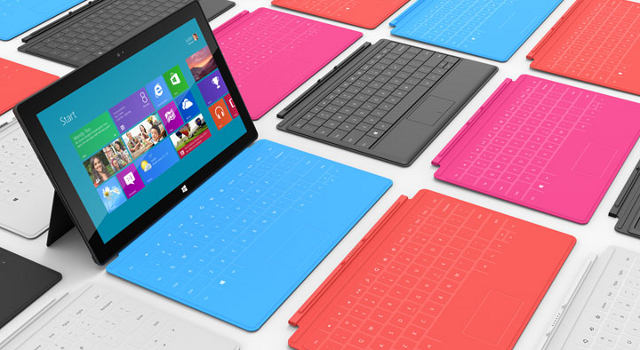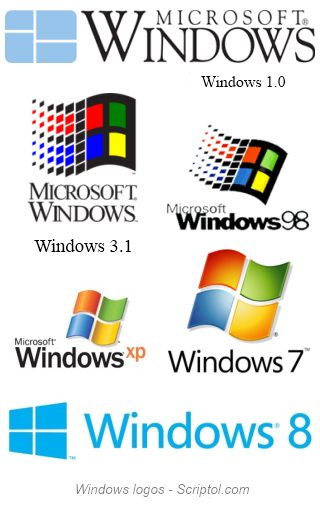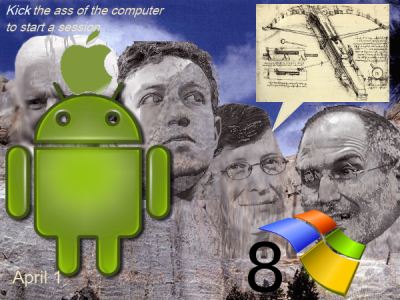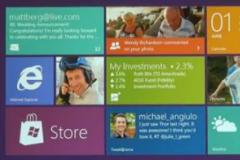Windows 8, for the computer of the future
Windows 8 is suitable for universal use of tablets, both on the go and in the office.
Due to the inability of desktop manufacturers to really evolve and deliver smaller components, users increasingly accustomed to smartphone machines will seek to use tablets as replacements by connecting them to a keyboard and monitor. And Windows 8 is great for that.
The developer version is available from September 2011 and the final version from October 2012.

Microsoft makes its own Windows 8 computers, the Surface, with a lid that also serves as a keyboard
New Features
We talked a lot of bad things about the new interface, and especially how difficult it is to go from Metro to a classic office, but I didn't experience anything television. In fact, I didn't feel really depoised, even with Metro, which is emerging as a new utility, without more.
The transition from Windows 7 to version 8 is like moving from one application to another: the interface may be different, but after a few moments we get acquainted. You just need to know to move the mouse around the corners of the screen to access the navigation screens.
It is for developers that the difference will be significant.
Metro description is the second part of this article, see tile (it is relevant) at the bottom of the page.

Other differences...
- Multi-monitor.
Control of multiple video monitors is now really taken into account using the taskbar and wallpaper, which are distributed across multiple screens.
You can subway on one screen, and the classic desktop on another. - History of vault .
This security feature automatically copies files like the Time Machine feature in MacIntosh.
We can revert to an earlier version of the file at any time. - Share.
Applications can share data, texts, and images. To do this, programmers are provided with an API, DataTransfer Manager. Sharing can also be done with social media. - Restoration.
With version 7, you can restore the system to its original state by saving files to your hard drive, but this erases the registry database and you need to reinstall the software. With version 8, this is useless. Third-party imaging and image recovery is also built into Windows. - ReFS (Resilient File System) is the successor to NTFS. Stability means elasticity. It has a data self-correction system and will support very large files and disks. Description (English).
- The start button is replaced by mouse movement (or DSS keys). When you move the mouse down, Metro appears to the left of the screen. On the right side is an icon table that replaces the traditional menu.
- Virtual DVD: the ISO image can be run on the hard disk as if it were written to an optical disk .
What we will no longer have
- The media center will no longer be integrated of its own accord. It has already been downloaded optionally in Europe, at the request of the authorities, but for free, while the Windows 8 Media Center package will be paid for it.
We won't be able to read DVDs either.
However, this absence is easily circumvented by VLC or XBMC .
The WPF runtin from Vista and Seven is replaced by WinRT, an abbreviation for Windows Runtime that runs on x86 and ARM .
Windows Store and other drawbacks
Not everything is so happy about the future system, Microsoft allegedly wants to be inspired by Apple, which is not an ideal for programmers.
In addition to internal software, you need to go through the Windows store to add an application to Metro.
Microsoft will deduct 30% of the software sales (reduced to 20% as soon as it collects $25,000). This is acceptable for new applications, but publishers of flagship products do not like it.
It will be able to remotely remove software already installed on your computer.
In order for the machine to use Windows 8, it will need a Microsoft-certified boot program. But Microsoft has denied that it could prevent Linux from being installed and running twice. The choice of activation will actually depend on the user.
Anecdote: False home screen
In order not to miss the tradition of jokes on April 1, the Windows 8 welcome screen was revealed. Despite the fact that it displays the date April 1 on the big chart, and it sounds at least fantastic, several of the most serious sites in the world picked up the information!.
In fact, these are wallpapers from Windows 7, to which fantastic text has been added.
| Windows 8 Home Screen! |  |
| Or maybe this one? |  |
ARM Processor Support
So far, Microsoft has offered one system for the desktop, another for servers and Windows Phone 7 for mobile and tablet PCs.
On the contrary, Windows 8 will be universal, its weight will depend on the hardware, a light version will work on a tablet or smartphone, and on mobile it will support widespread ARM processors.
According to the vice president of Intel, the ARM version (WOA) will not work with applications developed for previous versions of Windows, including Seven. But this contradicted Microsoft: the classic desktop works, of course, on an ARM processor and Microsoft applications such as Office, Excel, Powerpoint work well on this platform. For older applications, they will have to be recompiled if there is no emulator .
The ARM version is called Windows RT (not to be confused with WinRT). It is available only to manufacturers and not on store shelves. This version does not have Windows Media Player.
Only versions for x86/64, Windows 8 and Windows 8 pro processors will be available in stores.
If this does not happen, then this version does not support JIT (Just In Time), with the exception of Internet Explorer. Thus, other browsers will be slower than IE.
Analysis
There are three possible scenarios when on the new Modern UI/Metro platform:
- It has been massively adopted and a new standard is being set for tablets and desktops.
- Users mostly prefer to return to the classic platform, in which case it leads to the decline of Microsoft, as tablets seek to replace desktop computers.
- It is accepted by users, but competes with equivalent platforms from other providers (iOS, Tizen, Chrome OS,...). In this case, Microsoft loses its software leadership.
The third scenario looks most likely.
When in Windows 8 itself, each new Microsoft announcement portrays it more like a cash cow: After paying for the system, you will have to pay for extensions like Media Center, and then pay a percentage on Metro applications that will pay users for it.
